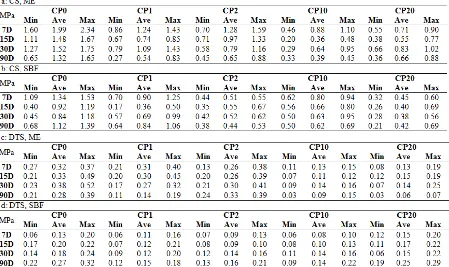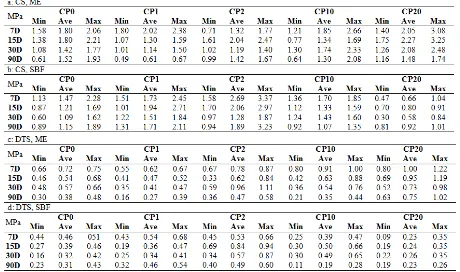The Effects of Excess Calcium and Aging Media on The Mechanical
Properties of Calcium Phosphate Filling Materials
A.S.F. Alqap
1, a, I. Sopyan
2,band Suryanto
2,c 1Mechanical Engineering Study Program, Faculty of Engineering, University of Bengkulu, Bengkulu, Indonesia
2
Department of Manufacturing and Materials Engineering, International Islamic University Malaysia, PO Box 10 Kuala Lumpur, Malaysia
a
[email protected], [email protected], [email protected]
Keywords: Calcium Phosphate; Hydrothermal; Excess Calcium; Single Pot; Calcium Deficient
Hydroxyapatite; Aging; Mechanical Strength.
Abstract. The effect of excess calcium and aging media on calcium phosphate biomaterials mechanical strength was studied. The variation of excess calcium and sample type has shown different performance when they are being aged in the moist environment (ME) and the simulated body fluid (SBF). The calcium phosphates were synthesized via low temperature hydrothermal method and sampled to two types of powder-water (3:2) mixture and paste for 90 days of the aging time. Two mechanical tests were applied, compression and diametrical tensile test, while XRD to evaluate phases. Scanning electron micrograph showed the paste samples that soaked in SBF was better entanglement of the particles, better compression strength but with degradation and diametrical tensile strength improvement by aging. Calcium hydroxide and ammonium di-hydrogen phosphoric was traced in all the samples along with calcium deficient hydroxyapatite as the main phase.
Introduction
The ability to form apatite at physiological temperature is essential if a biocompatible, biodegradable bone replacement is to develop. It has been demonstrated that apatite can be formed at low temperature by a cement-like reaction [1]. This occurs by an acid-base reaction involving tetracalcium phosphate or -tricalcium phosphate with an acidic calcium phosphate, such as monocalcium phosphate monohydrate, anhydrous dicalcium phosphate, or dicalcium phosphate dihydrate.
Regardless the advantage of the products mechanical properties, bone is smart environment, into which biocompatible non-toxic material being implanted is coordinative with the host hard tissue then modifies and substitutes as a new hard tissue. Once filler is put in bone tissue the filler strengthening is accomplished by bone remodeling. It even was noted that an interface as result of bone remodeling between the host bone and the ceramic implant may have strength greater than the host bone and the implant [2]. Beside, the positioning of the implant determines success of biomaterial application [2,3]. Less crystalline hydroxyapatite and Ca-deficient hydroxyapatite (CDHA) play important roles in bone remodeling and bone formation. These considerations and flexible needs in application make research on this material always interesting.
Materials and Methods
The CP biomaterial was prepared from calcium oxide granules (CaO) (Techno Pharmchem, India) and ammonium di-hydrogen phosphate (NH4H2PO4) (Systerm, Malaysia) as the precursors with
distilled water as the solvent. For the preparation of the solution, a stoichiometric weight of calcium oxide was mixed with distilled water with vigorous stirring to get a soluble suspension. Into this suspension, ammonium di-hydrogen phosphate powder on the base of 1.67 Ca/P was then added dropwise. The synthesis temperature was between 80-100°C up to paste was obtained. Four synthesized pastes of different excess Ca were prepared: 0, 1, 2, 10 and 20% excess CaO (labeled as CP0, CP1, CP2, CP10 and CP20 respectively). The products were than treated as shown in Fig. 1.
Fig. 1: Flow diagram of the work
The paste was divided into two groups: with drying and without drying. The first, it was dried overnight at 80°C in an oven, then mixed with water as the ratio of powder and water of 3:2. Filled and loaded by hand through steel bar without specific loading force in 6 mm D x 12 mm H and 6 mm D x 3 mm H Teflon moulds, ejected and put in a closed polyethylene box containing moist (moist environment, ME) and being aged for 7d, 15d, 30d and 90d (d is short form of days) in the room temperature. The second, the paste was kept as paste and when the weight was 80% of yield (with the range of - 0% / +10%) the synthesis process was stopped and it was molded by the same procedure, then left as such in the moulds and put in the polyethylene box containing Kokubo’s SBF controlled in 37.5°C with initial pH 7.25. After the same aging times the samples were released out, ejected, dried at 50°C over night before the mechanical tests performing by using a Lloyd LR 10 K+ Universal Testing Machine under 1 mm/min crosshead rate of compression and 0.5 mm/min of diametrical tensile tests.
Results and Discussion
Fig. 2: Phase changing of the (3:2) p/w samples over aging times
Fig. 3: Phase changing of the Paste samples over aging times.
Fig. 4 shows the effect of aging on the compression and diametrical tensile strengths of the (3:2) p/w samples. The excess CaO reduced the strength of (3:2) after aging in ME and SBF as well (Fig. 4a-b). The soaking in SBF was not helpful to improve the strength, additionally no improvement after aging was observed from these two media. DTS of the samples were low (Fig. 4c-d) however soaking in SBF showed some improvements. This improvement may be due to SBF entered in the thinner samples thoroughly.
It is shown that the strength of the Paste (Fig. 5) was higher than that of the (3:2) p/w (Fig. 4) and this was attributed with better particles entanglement within the sample (see Fig. 6). Degradation of the (3:2) strengths by ME was higher than that by SBF, however, it was not clear for the degradation of the paste ones. The superior strength was achieved by the paste CP2 when soaked in SBF (Fig. 5). The mechanical strength data indicated that the technique can be applied for non load bearing bone implant. The advantage of the paste system also was from excellent injectability as reported elsewhere [5].
Fig. 5: Mechanical changing of the Paste samples over aging times.
(3:2) p/w Paste
Summary
The mechanical test of CP biomaterial prepared by single pot technique has been successfully done to elucidate the effects of excess CaO, preparation technique and aging condition. The results show that the increase in the excess CaO reduces the strength but not in the case of Paste. The preparation technique of paste results in better entanglement of the particles. For examples, the compression strengths (MPa) of CP0, CP1, CP2, CP10 and CP20 are 1.99, 1.24, 1.28, 1.10 and 0.71 respectively for 7D aging samples made of powder, and 1.80, 2.62, 1.32, 1.85 and 2.05 for those made of paste; meanwhile their diametrical tensile strengths (MPa) are 0.32, 0.31, 0.26, 0.13 and 0.13 respectively for the former group samples, and 0.72, 0.62, 0.78, 0.91 and 1.00 for the laters.
Acknowledgment
Biomedical Engineering Research Group (BERG) at International Islamic University of Malaysia supported this technical works.
References
[1] S. Jalota, A.C. Tas and S.B. Bhaduri: J. Am. Ceram. Soc., Vol. 88 (2005), p. 3353
[2] V.A. Dubok: Powder Metal. Metal Ceram., Vol. 39 (2000), p. 381.
[3] I.H. Kalfas: Neurosurg. Focus, Vol. 10 (2001), p. 7.
[4] A.S.F. Alqap, I. Sopyan and S.A. Zubir: Adv. Mater. Res. Vol. 93-94 (2010), p. 405


